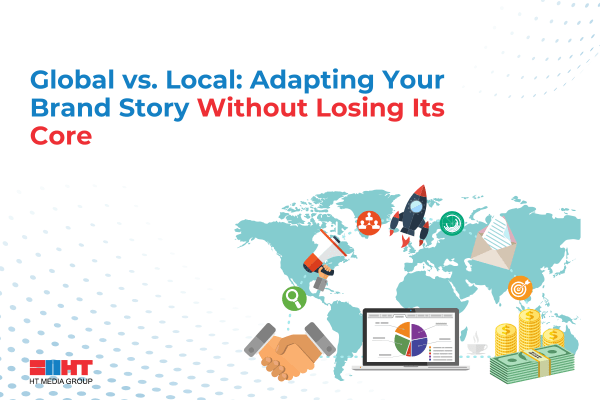When you start taking your brand outside of its original market, you face a major obstacle in telling your brand story and messaging: how do you localize your brand, without losing its strength and continuity across the world? It is a fine line because being too inconsistent may water down your brand, and being too deaf to local culture may render your brand as being out of touch. The aim is to be internationally known but locally cherished.
Understanding the Tension Between Global Consistency and Local Relevance
Such an inherent tension exists with every CMO with multiple markets. On one hand, global consistency creates familiarity, confidence, and coherent image that customers are acquainted with regardless of their geographic location. Consider such brands worldwide as Coca-Cola or Nike, the essence of their message goes around the globe, and people instantly know it. This uniformity assists in developing scales of economy in messaging and asset development. Conversely, local relevance involves talking to the cultural specificities, the values peculiar to a particular region or market, and even to the sense of humor there. Unless your brand story feels real and close to the local customs and preferences, it just won to resonate with the audience, regardless of how well you have established a presence globally. The trick is to strike the balance where your brand can be recognised and accepted by everyone on a global level, but be intimate and culturally specific to the individual local consumer.
Defining Your Core Brand DNA
You need a rock-solid knowledge of what the core DNA of your brand is and you can only do this before any adaptation process starts. This consists of clearly articulating and recording the everlasting aspects of your brand narrative:
- Purpose: The core motive why your brand is present, and it is not only to gain a profit. This is the final why of your brand.
- Promise: What the brand can be depended upon to give to the customers and what the customer will never stop expecting.
- Core Values: The values of doing, making decisions, and behavior that influence your brand.
- Iconography and Visual Identity: Your special logo, unified color scheme, typeface and style that can identify your brand with a single look.
- Tone of Voice: The general character and the way your brand speaks, either it is solemn, humorous, authoritative or emotional.
These are the non-negotiables. They constitute the stable foundation of your brand narrative and cannot be changed, no matter the country or the culture you are operating in. They are the international pegs that do not allow your brand to become a conglomeration of localized forms.
Frameworks for Localization and Adaptation
You now have a strong DNA and you can inject frameworks that enable intelligent localization. It also lies on how local teams can localise the brand story in a way that is both authentic and effective on their local market.
- Localize relevance: Allow the local teams to adapt the manner in which campaigns are executed. This can be seen in the selection of the right words (not the translation, but transcreation, the transmutation of meaning and culture), the right visuals that will be attractive to the locals, presentation of the messages, how to present the message that will be attractive to the local style of communication and the preference of the locals. The brand story has not changed, just that it is local, within reach.
Build Guardrails, not Handcuffs: Build short rules on what must be consistent across the world (e.g. your core use of the logo, core tagline or basic value statement). In the meantime, explain why you are not only allowed to adapt locally, but why it is highly and conveniently permissible to do so. This may include local referencing of a culture, local and effective humour in a given culture, local celebrities, and case studies of the clients in a given specific region. The process allows the required form of structure but does not compromise creativity and cultural belonging that is essential in order to succeed in the region.
Cultural Intelligence in Brand Storytelling
Adaptation does not imply translation of the language but rather an in-depth knowledge of the local culture and consumer psychology.
- Value Local Intelligence: Be active in identification and use of local research and customer intelligence. Get your regional teams to carry out the correct type of market research and show you what actually counts to them in the local scene such as national festivals and social traditions, the major product trigger or some consumer behaviours that are unique to their marketplace. These local insights can allow you to not only make your campaigns capable of effectively playing to the local audiences, but it will give the impression that it was created with this audience in mind, as opposed to it being a translation.
- Find local partners: Find local partners in local teams, agencies or cultural consultants that have a good on-the-ground knowledge of the market. This teamwork will be necessary so that not only your content would be culturally competent and acceptable but would be actually quite resonant and you would not make a faux pas that will burn your brand and push away the local clientele.
Governance and Brand Integrity
Creating a balance between global brand integrity and local flexibility which is necessary needs careful governance and careful organizational structure.
- Centralized Brand Management with Decentralized Activation: The overall global brand story and the brand strategic direction needs to be developed and managed centrally to ensure to achieve global consistency as well as a unified message. Nevertheless, carrying out and implementing marketing campaigns themselves are usually more efficient when left to local teams. This enables faster adaptations to changes in the local market, and guaranteeing that your messages resonate as natural and relevant, without having to sacrifice the continuity of your global brand marketing in terms of its core identity.
- Effective Guidelines and Training: Establish effective brand guidelines that would be easy to understand and use among all teams. Conduct periodic training to the local teams on the use of these guidelines and how to be creative within the available parameters. This will assist in achieving quality and uniformity in all markets.
- Review Processes: To come up with a systematic reviewing process that would make sure that local adaptations are still in line with the core brand but also allow the local teams to have the autonomy they require. This could be a core brand team or a regional hub that reviews before the launch of the key campaign aspects to identify any possible inconsistencies or misinterpretations.
The Role of Technology and Data
Technology and information are the best friends of successful management of a global brand story and its localized versions.
- Digital Asset Management (DAM) Systems: Use DAM systems to get all the approved brand resources (logos, images, videos, messaging templates, voice guidelines) in one place. This will guarantee that the local teams will ever be using and having the appropriate versions of your brand components, and then the appearance and message will be the same.
- Regional Segmentation: Analytical dashboards: You ought to be in a position to monitor the performance of the campaigns region by region. These dashboards can then guide the future adaptation plans and it is clear what can be utilised on the ground and what needs to be updated. This kind of data-driven strategy can boost your long-term localization efforts.
- Localizable Content Management Systems (CMS): Consider a CMS with in-built support of localization, i.e. via support of different languages, regional variations of content. This will be very useful in assisting a lot of controlling, launching as well as modification of localized variations of your brand story on various platforms and channels.
HT Brand Studio: Crafting Your Global-Local Brand Story
Striking the right balance between worldwide coherence and local significance of your brand narrative is a tricky task as it requires accuracy and cultural awareness. The HT brand studio has specialized in the process of guiding brands through this challenge. We help you to clarify your inner brand narrative then partner with your local teams to localize content in a manner that is truly culturally minded, without undermining what you have already established as your global image. We have the expertise to develop tailor-made content that resonates with various audiences through compelling articles, engaging videos, and more, making sure that your brand marketing will get a connection with the audience, regardless of your location. We assist you to create a brand narrative that will keep its power and familiarity across the globe and actually capture local hearts and minds.
Frequently Asked Questions
What is a brand story?
A brand story is the narrative of how your brand came to be, why it exists, what it stands for, and what values it has. It is not only about the facts, but the emotional connection that enables your customers to comprehend and associate themselves with your brand at a more intimate level. A good brand narrative is also congruent throughout your touchpoints and assists you in setting yourself apart.
Why is balancing global consistency and local relevance important for a brand?
It matters because global consistency creates a sense of recognition, trust and one brand image, and local relevance makes your brand story resonate with the specific cultural contexts and preferences. This balance will make a brand equally popular and beloved in different markets.
What are "guardrails" in brand localization?
Guardrails refer to rules that establish the non-negotiable aspects of a brand (such as its logo, core values, or main messaging) that should not change across the world. They also give zones where the local teams are free to modify content, language and visuals to be relevant to the local culture without losing the main essence of the brand.
How do companies ensure cultural relevance in their brand story?
Cultural relevance entails working with local teams, agencies, or cultural consultants who have knowledge of their marketplace. These include the local studies, cultural conventions, jokes and stimulants of a given market. The point is to make sure that the brand story does not sound like a literal translation but like it is natural and authentic to the local audience.
What role does technology play in managing global vs. local brand storytelling?
Technology has its role too and offers such tools as Digital Asset Management (DAM) systems to centralize brand assets, performance dashboards which can be segmented by region, Content Management Systems (CMS) with localization features. The tools facilitate consistent messaging across the globe, and they enable local customization and decentralized activation.
Ready to take your brand to the next level? Connect with us today to explore how HT Media can amplify your presence across our diverse portfolio of 25+ brands and properties. Let's turn your brand vision into reality!

















Comment